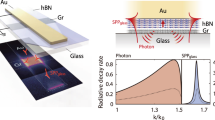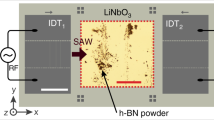Abstract
The ultrafast conversion of electrical signals to optical signals at the nanoscale is of fundamental interest for data processing, telecommunication and optical interconnects. However, the modulation bandwidths of semiconductor light-emitting diodes are limited by the spontaneous recombination rate of electron–hole pairs, and the footprint of electrically driven ultrafast lasers is too large for practical on-chip integration. A metal–insulator–metal tunnel junction approaches the ultimate size limit of electronic devices and its operating speed is fundamentally limited only by the tunnelling time. Here, we study the conversion of electrons (localized in vertical gold–hexagonal boron nitride–gold tunnel junctions) to free-space photons, mediated by resonant slot antennas. Optical antennas efficiently bridge the size mismatch between nanoscale volumes and far-field radiation and strongly enhance the electron–photon conversion efficiency. We achieve polarized, directional and resonantly enhanced light emission from inelastic electron tunnelling and establish a novel platform for studying the interaction of electrons with strongly localized electromagnetic fields.
This is a preview of subscription content, access via your institution
Access options
Subscribe to this journal
Receive 12 print issues and online access
$259.00 per year
only $21.58 per issue
Buy this article
- Purchase on Springer Link
- Instant access to full article PDF
Prices may be subject to local taxes which are calculated during checkout






Similar content being viewed by others
References
Bharadwaj, P., Deutsch, B. & Novotny, L. Optical antennas. Adv. Opt. Phot. 1, 438–483 (2009).
Alù, A. & Engheta, N. Input impedance, nanocircuit loading, and radiation tuning of optical nanoantennas. Phys. Rev. Lett. 101, 043901 (2008).
Greffet, J.-J., Laroche, M. & Marquier, F. Impedance of a nanoantenna and a single quantum emitter. Phys. Rev. Lett. 105, 117701 (2010).
Novotny, L. & van Hulst, N. F. Antennas for light. Nature Photon. 5, 83–90 (2011).
Biagioni, P., Huang, J.-S. & Hecht, B. Nanoantennas for visible and infrared radiation. Rep. Prog. Phys. 75, 024402 (2012).
Schuller, J. A. et al. Plasmonics for extreme light concentration and manipulation. Nature Mater. 9, 193–204 (2010).
Mühlschlegel, P., Eisler, H.-J., Martin, O. J. F., Hecht, B. & Pohl, D. W. Resonant optical antennas. Science 308, 1607–1609 (2005).
Curto, A. G. et al. Unidirectional emission of a quantum dot coupled to a nanoantenna. Science 329, 930–933 (2010).
Kinkhabwala, A. et al. Large single-molecule fluorescence enhancements produced by a bowtie nanoantenna. Nature Photon. 3, 654–657 (2009).
Atwater, H. A. & Polman, A. Plasmonics for improved photovoltaic devices. Nature Mater. 9, 205–213 (2010).
Tang, L. et al. Nanometre-scale germanium photodetector enhanced by a near-infrared dipole antenna. Nature Photon. 2, 226–229 (2008).
Knight, M. W., Sobhani, H., Nordlander, P. & Halas, N. J. Photodetection with active optical antennas. Science 332, 702–704 (2011).
Huang, K. C. et al. Electrically driven subwavelength optical nanocircuits. Nature Photon. 8, 244–249 (2014).
Lambe, J. & McCarthy, S. L. Light emission from inelastic electron tunneling. Phys. Rev. Lett. 37, 923 (1976).
Kirtley, J., Theis, T. & Tsang, J. Light emission from tunnel junctions on gratings. Phys. Rev. B 24, 5650 (1981).
Sparks, P., Sjodin, T., Reed, B. & Stege, J. Light emission from the slow mode of tunnel junctions on short period diffraction gratings. Phys. Rev. Lett. 68, 2668 (1992).
Gimzewski, J. K., Reihl, B., Coombs, J. H. & Schlittler, R. R. Photon emission with the scanning tunneling microscope. Z. Phys. B 72, 497–501 (1988).
Schull, G., Néel, N., Johansson, P. & Berndt, R. Electron–plasmon and electron–electron interactions at a single atom contact. Phys. Rev. Lett. 102, 057401 (2009).
Chen, C., Bobisch, C. A. & Ho, W. Visualization of Fermi's Golden Rule through imaging of light emission from atomic silver chains. Science 325, 981–985 (2009).
Bharadwaj, P., Bouhelier, A. & Novotny, L. Electrical excitation of surface plasmons. Phys. Rev. Lett. 106, 226802 (2011).
Zhang, Y. et al. Edge scattering of surface plasmons excited by scanning tunneling microscopy. Opt. Express 21, 13938–13948 (2013).
Davis, L. Theory of surface-plasmon excitation in metal–insulator–metal tunnel junctions. Phys. Rev. B 16, 2482 (1977).
Rendell, R. W. & Scalapino, D. J. Surface plasmons confined by microstructures on tunnel junctions. Phys. Rev. B 24, 3276–3294 (1981).
Johansson, P., Monreal, R. & Apell, P. Theory for light emission from a scanning tunneling microscope. Phys. Rev. B 42, 9210–9213 (1990).
Persson, B. N. J. & Baratoff, A. Theory of photon emission in electron tunneling to metallic particles,. Phys. Rev. B 68, 3224–3227 (1992).
Aizpurua, J., Apell, S. P. & Berndt, R. Role of tip shape in light emission from the scanning tunneling microscope. Phys. Rev. B 62, 2065–2073 (2000).
Landauer, R. & Martin, T. Barrier interaction time in tunneling. Rev. Mod. Phys. 66, 217 (1994).
Shafir, D. et al. Resolving the time when an electron exits a tunnelling barrier. Nature 485, 343–346 (2012).
Ward, D. R., Hüser, F., Pauly, F., Cuevas, J. C. & Natelson, D. Optical rectification and field enhancement in a plasmonic nanogap. Nature Nanotech. 5, 732–736 (2010).
Lee, G.-H. et al. Electron tunneling through atomically flat and ultrathin hexagonal boron nitride. Appl. Phys. Lett. 99, 243114 (2011).
Britnell, L. et al. Electron tunneling through ultrathin boron nitride crystalline barriers. Nano Lett. 12, 1707–1710 (2012).
Watanabe, K., Taniguchi, T. & Kanda, H. Direct-bandgap properties and evidence for ultraviolet lasing of hexagonal boron nitride single crystal. Nature Mater. 3, 404–409 (2004).
Koerkamp, K. J. K., Enoch, S., Segerink, F. B., van Hulst, N. F. & Kuipers, L. Strong influence of hole shape on extraordinary transmission through periodic arrays of subwavelength holes. Phys. Rev. Lett. 92, 183901 (2004).
Garcia-Vidal, F., Moreno, E., Porto, J. & Martin-Moreno, L. Transmission of light through a single rectangular hole. Phys. Rev. Lett. 95, 103901 (2005).
Gordon, R. et al. Strong polarization in the optical transmission through elliptical nanohole arrays. Phys. Rev. Lett. 92, 037401 (2004).
Miyazaki, H. T. & Kurokawa, Y. Squeezing visible light waves into a 3-nm-thick and 55-nm-long plasmon cavity. Phys. Rev. Lett. 96, 097401 (2006).
Chen, X. et al. Atomic layer lithography of wafer-scale nanogap arrays for extreme confinement of electromagnetic waves. Nature Commun. 4, 2361 (2013).
Nagpal, P., Lindquist, N. C., Oh, S.-H. & Norris, D. J. Ultrasmooth patterned metals for plasmonics and metamaterials. Science 325, 594–597 (2009).
Huang, J. et al. Atomically flat single-crystalline gold nanostructures for plasmonic nanocircuitry. Nature Commun. 1, 150 (2010).
Novotny, L. & Hecht, B. Principles of Nano-Optics 2nd edn (Cambridge Univ. Press, 2012).
Yang, H. U. et al. Accessing the optical magnetic near-field through Babinet's principle. ACS Photon. 1, 894–899 (2014).
Schneider, N. L., Johansson, P. & Berndt, R. Hot electron cascades in the scanning tunneling microscope. Phys. Rev. B 87, 045409 (2013).
Coenen, T. & Polman, A. Optical properties of single plasmonic holes probed with local electron beam excitation. ACS Nano 8, 7350–7358 (2014).
Bigourdan, F., Marquier, F., Hugonin, J.-P. & Greffet, J.-J. Design of highly efficient metallo-dielectric patch antennas for single-photon emission. Opt. Express 22, 2337–2347 (2014).
Akselrod, G. M. et al. Probing the mechanisms of large Purcell enhancement in plasmonic nanoantennas. Nature Photon. 8, 835–840 (2014).
Khurgin, J. B. & Sun, G. In search of the elusive lossless metal. Appl. Phys. Lett. 96, 181102 (2010).
Boltasseva, A. & Atwater, H. A. Low-loss plasmonic metamaterials. Science 331, 290–291 (2011).
Tassin, P., Koschny, T., Kafesaki, M. & Soukoulis, C. M. A comparison of graphene, superconductors and metals as conductors for metamaterials and plasmonics. Nature Photon. 6, 259–264 (2012).
Geim, A. & Grigorieva, I. Van der waals heterostructures. Nature 499, 419–425 (2013).
Taniguchi, T. & Watanabe, K. Synthesis of high-purity boron nitride single crystals under high pressure by using Ba–BN solvent. J. Cryst. Growth 303, 525–529 (2007).
Novoselov, K. S. et al. Electric field effect in atomically thin carbon films. Science 306, 666–669 (2004).
Novoselov, K. S. et al. Two-dimensional atomic crystals. Proc. Natl Acad. Sci. USA 102, 10451 (2005).
Levinshtein, M. E., Rumyantsev, S. L. & Shur, M. S. Properties of Advanced Semiconductor Materials: GaN, AIN, InN, BN, SiC, SiGe (Wiley, 2001).
Johnson, P. B. & Christy, R. W. Optical constants of the noble metals. Phys. Rev. B 6, 4370–4379 (1972).
Acknowledgements
The authors thank Z.J. Lapin for sample fabrication by focused ion beam milling, K. Luszcz for support regarding the frequency modulation experiments, and M. Kasperczyk and D.W. Pohl for helpful discussions. Funding by the NCCR-QSIT programme (grant no. 51NF40-160591) and the Swiss National Science Foundation (grant no. 200021_149433) is appreciated. The authors also acknowledge the use of facilities at the FIRST Center for Micro- and Nanotechnology as well as the Scientific Center for Optical and Electron Microscopy (ScopeM) at ETH Zürich. K.W. and T.T. acknowledge support from the Elemental Strategy Initiative conducted by the MEXT, Japan. T.T. acknowledges support from a Grant-in-Aid for Scientific Research (grant no. 262480621) and on Innovative Areas ‘Nano Informatics’ (grant no. 25106006) from JSPS.
Author information
Authors and Affiliations
Contributions
L.N., P.B. and M.P. conceived the research. M.P. fabricated the samples and carried out the numerical simulations. M.P. and P.B. measured the samples. A.J. developed the transfer technique. K.W. and T.T. synthesized the h-BN crystals. M.P., P.B. and L.N. discussed the results and co-wrote the paper.
Corresponding author
Ethics declarations
Competing interests
The authors declare no competing financial interests.
Supplementary information
Supplementary information
Supplementary information (PDF 1775 kb)
Rights and permissions
About this article
Cite this article
Parzefall, M., Bharadwaj, P., Jain, A. et al. Antenna-coupled photon emission from hexagonal boron nitride tunnel junctions. Nature Nanotech 10, 1058–1063 (2015). https://doi.org/10.1038/nnano.2015.203
Received:
Accepted:
Published:
Issue Date:
DOI: https://doi.org/10.1038/nnano.2015.203
This article is cited by
-
Exciton-assisted electron tunnelling in van der Waals heterostructures
Nature Materials (2023)
-
Out-of-equilibrium phonons in gated superconducting switches
Nature Electronics (2022)
-
Atomic scale memristive photon source
Light: Science & Applications (2022)
-
Optical Anisotropy in van der Waals materials: Impact on Direct Excitation of Plasmons and Photons by Quantum Tunneling
Light: Science & Applications (2021)
-
Highly-efficient electrically-driven localized surface plasmon source enabled by resonant inelastic electron tunneling
Nature Communications (2021)



